Themed collection Nanomaterials for Energy Conversion and Storage

Themed issue: nanomaterials for energy conversion and storage
Guest editors Michael Grätzel and Kuppuswamy Kalyanasundaram introduce this Journal of Materials Chemistry themed issue on nanomaterials for energy conversion and storage.

J. Mater. Chem., 2012,22, 24190-24194
https://doi.org/10.1039/C2JM90163C
Unusual energy enhancement in carbon-based electrochemical capacitors
High energy and eco-friendly supercapacitors are now accessible in aqueous medium through either redox reactions at the carbon–electrolyte interface or high over-potential for dihydrogen evolution.
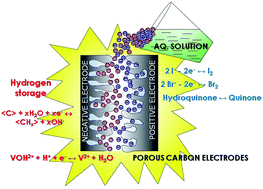
J. Mater. Chem., 2012,22, 24213-24223
https://doi.org/10.1039/C2JM35711A
Graphene -based Schottky junction solar cells
This highlight reviews the recent researches and developments of graphene-based Schottky junction solar cells, including graphene-on-silicon Schottky junction solar cells, and graphene/ single nanowire (nanobelt) Schottky junction solar cells.
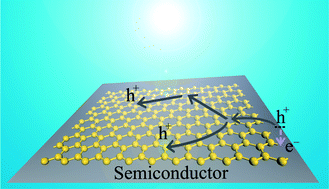
J. Mater. Chem., 2012,22, 24224-24229
https://doi.org/10.1039/C2JM33809B
Metal oxides for interface engineering in polymer solar cells
Significant progress in power conversion efficiencies and stabilities of polymer solar cells has been achieved using semiconducting metal oxides as charge extraction interlayers.
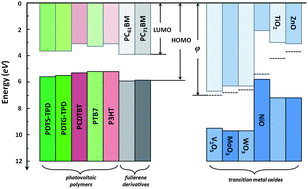
J. Mater. Chem., 2012,22, 24202-24212
https://doi.org/10.1039/C2JM33838F
Advances in high efficiency dye sensitized solar cells based on Ru(II) free sensitizers and a liquid redox electrolyte
Our highlight describes the utmost important advances in the design and synthesis of ruthenium free sensitizers for efficient Grätzel solar cells.

J. Mater. Chem., 2012,22, 24195-24201
https://doi.org/10.1039/C2JM34289H
Open-circuit voltage in organic solar cells
Recent progress in understanding the origin of open-circuit voltage in OSCs is reviewed. Based on the model of DOS, disorder in donor–acceptor materials and bimolecular recombination are two main sources of open-circuit voltage loss.

J. Mater. Chem., 2012,22, 24315-24325
https://doi.org/10.1039/C2JM33719C
Carbon nanodots: synthesis, properties and applications
Carbon dots for potential applications in photocatalysis, optoelectronics, sensor, SERS, and bio-imaging.
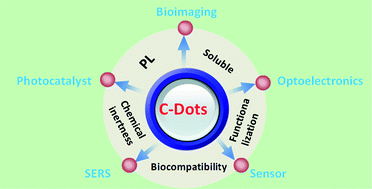
J. Mater. Chem., 2012,22, 24230-24253
https://doi.org/10.1039/C2JM34690G
Top-down meets bottom-up: organized donor–acceptor heterojunctions for organic solar cells
This review summarizes recent progress on both materials synthesis and self-assembly and lithography techniques toward ordered nanostructures and well-defined D/A interfaces that are expected to enhance the performance of organic solar cells.
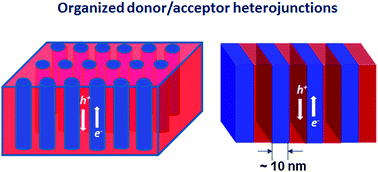
J. Mater. Chem., 2012,22, 24297-24314
https://doi.org/10.1039/C2JM33756H
Catalytic activity of metal-based nanoparticles for photocatalytic water oxidation and reduction
This article presents water reduction by non-Pt metal nanoparticles and water oxidation by metal oxide nanoparticles prepared from metal complexes.
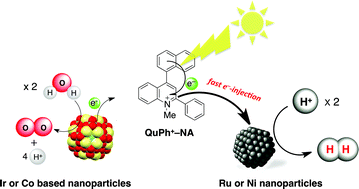
J. Mater. Chem., 2012,22, 24284-24296
https://doi.org/10.1039/C2JM32926C
Degradation and stability of polymer -based solar cells
The degradation mechanisms of active layer materials are discussed and their protection from degradation are extensively discussed.

J. Mater. Chem., 2012,22, 24265-24283
https://doi.org/10.1039/C2JM33645F
Graphene-based transparent flexible electrodes for polymer solar cells
Graphene is becoming a potential alternative to indium tin oxide (ITO) for use as the electrode material in electronic devices.

J. Mater. Chem., 2012,22, 24254-24264
https://doi.org/10.1039/C2JM33784C
Absolute quantum yields in NaYF4 :Er,Yb upconverters – synthesis temperature and power dependence
We investigate the temperature and power dependence of the emission quantum yield of NaYF4:Er,Yb upconverters. We demonstrate that formation of the hexagonal phase of this material is not in itself sufficient to guarantee high upconversion efficiency

J. Mater. Chem., 2012,22, 24330-24334
https://doi.org/10.1039/C2JM33457G
Electrospun nest-shaped TiO2 structures as a scattering layer for dye sensitized solar cells
An electrospun nest-shaped TiO2 structure is used as a scattering layer on a P25 electrode for dye sensitized solar cells.
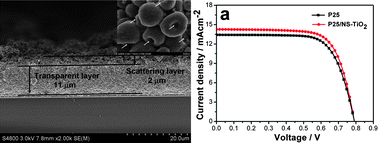
J. Mater. Chem., 2012,22, 24326-24329
https://doi.org/10.1039/C2JM33219A
Investigation of the stability of paraffin–exfoliated graphite nanoplatelet composites for latent heat thermal storage systems
Control of processing parameters increases the stability of graphite–wax composites for thermal energy storage (stable system: right; unstable system: left).

J. Mater. Chem., 2012,22, 24469-24476
https://doi.org/10.1039/C2JM35112A
Effect of the structure transformation on the (de-)hydrogenation hysteresis of La1−zYzHx films as studied by hydrogenography
The (de-)hydrogenation properties of La1−zYzHx (z = 0, 0.4, 1) thin films during the dihydride–trihydride transition were investigated by means of hydrogenography.
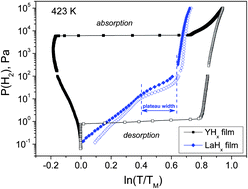
J. Mater. Chem., 2012,22, 24453-24462
https://doi.org/10.1039/C2JM34594C
Reducing recombination in ZnO photoanodes for dye sensitised solar cells through simple chemical synthesis
A ZnO NW film with lower recombination centers has been developed, which demonstrates superior photovoltaic performance within a DSSC.

J. Mater. Chem., 2012,22, 24463-24468
https://doi.org/10.1039/C2JM34904C
Comparative studies of photochemical cross-linking methods for stabilizing the bulk hetero-junction morphology in polymer solar cells
Bromine, azide, vinyl and oxetane were incorporated into the side chains of the polymer TQ1. Cross-linking of the polymers was achieved by UV-light illumination to give solvent resistant films and reduced growth of PCBM crystallites.

J. Mater. Chem., 2012,22, 24417-24423
https://doi.org/10.1039/C2JM34284G
Understanding the stability of fluorosulfate Li-ion battery cathode materials: a thermochemical study of LiFe1−xMnxSO4F (0 ≤ x ≤ 1) polymorphs
Tavorite and triplite are equally stable at ambient temperature but triplite is thermodynamically favored at high temperatures because of entropy.

J. Mater. Chem., 2012,22, 24446-24452
https://doi.org/10.1039/C2JM34071B
Dye -sensitized solar cells incorporating novel Co(II/III) based-redox electrolytes solidified by silica nanoparticles
An innovative solidified redox electrolyte for dye-sensitized solar cells (DSCs) was prepared by incorporating amorphous silica nanoparticles in a liquid system containing the Co2+/Co3+ shuttle dissolved in methoxypropionitrile. The incorporation of the solidified electrolyte in a DSC configuration resulted in an efficiency up to about 4% under 0.23 sun (AM 1.5G) illumination.
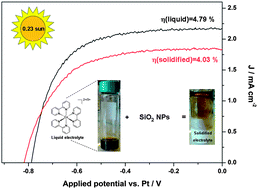
J. Mater. Chem., 2012,22, 24430-24438
https://doi.org/10.1039/C2JM33752E
Influence of cations of the electrolyte on the performance and stability of dye sensitized solar cells
Novel electrolytes for high performance and stable dye sensitized solar cells.

J. Mater. Chem., 2012,22, 24424-24429
https://doi.org/10.1039/C2JM34706G
Facile synthesis of nanostructured vanadium oxide as cathode materials for efficient Li-ion batteries
Homogeneous VO2 (B) nanorods approximately 100 nm in width and 1–2 μm in length have been fabricated via the hydrothermal process, and are then transformed into irregularly shaped V2O5 nanoparticles several hundreds of nanometers large and 20–30 nm thick after annealing the precursor material at 500 °C for 30 min.
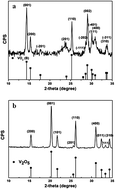
J. Mater. Chem., 2012,22, 24439-24445
https://doi.org/10.1039/C2JM34078J
Charge separation dynamics in a narrow band gap polymer –PbS nanocrystal blend for efficient hybrid solar cells
An opportune mixing of PbS nanocrystals and a narrow band gap polymer led to hybrid solar cells with a broad spectral response and an efficiency of ∼3%.
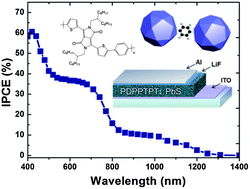
J. Mater. Chem., 2012,22, 24411-24416
https://doi.org/10.1039/C2JM34034H
Electrochemically exfoliated graphene using 9-anthracene carboxylic acid for supercapacitor application
Water dispersible graphene has been prepared by electrochemical exfoliation of graphite for energy storage electrode materials.
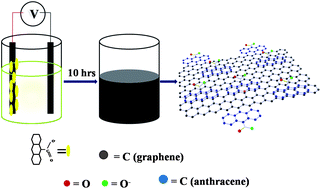
J. Mater. Chem., 2012,22, 24403-24410
https://doi.org/10.1039/C2JM34838A
Synthesis of low bandgap polymers based on thienoquinodimethane units and their applications in bulk heterojunction solar cells
Non-fused ring building blocks of electron-rich quinoid structures have been used in low bandgap polymers for organic solar cells.

J. Mater. Chem., 2012,22, 24394-24402
https://doi.org/10.1039/C2JM33637E
Semiconductor amphiphilic block copolymers for hybrid donor–acceptor nanocomposites
Semiconductor amphiphilic block copolymers, which form uniform micelles in water, were combined with inorganic semiconductor nanoparticles to create well defined donor–acceptor nanocomposites with domain sizes suitable for photovoltaic applications.
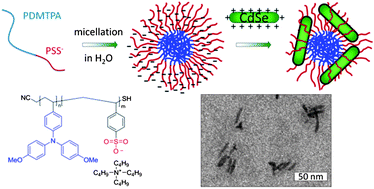
J. Mater. Chem., 2012,22, 24386-24393
https://doi.org/10.1039/C2JM34033J
Nanowires of oligothiophene-functionalized naphthalene diimides: self assembly , morphology, and all-nanowire bulk heterojunction solar cells
All-nanowire bulk heterojunction organic solar cells incorporating nanowires of oligothiophene-functionalized naphthalene diimide as electron acceptor and poly(3-hexylthiophene) nanowires as electron donor are demonstrated.
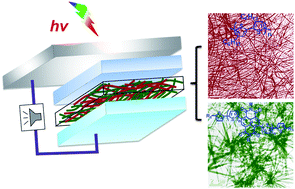
J. Mater. Chem., 2012,22, 24373-24379
https://doi.org/10.1039/C2JM33787H
Facile solvothermal synthesis of anatase TiO2 microspheres with adjustable mesoporosity for the reversible storage of lithium ions
TiO2 microspheres with adjustable morphologies and microstructures fabricated by a facile solvothermal process were evaluated for their reversible Li+ storage properties.
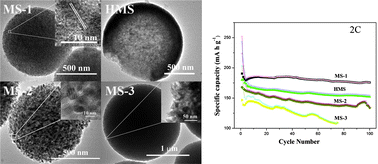
J. Mater. Chem., 2012,22, 24380-24385
https://doi.org/10.1039/C2JM33724J
Protic ionic liquid -functionalized mesoporous silica-based hybrid membranes for proton exchange membrane fuel cells
The conductivity of the composite membrane at 90 °C and 30% humidity was noted to be 54.6 mS cm−1.
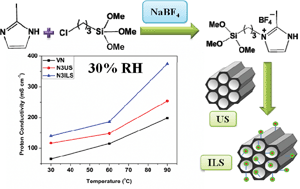
J. Mater. Chem., 2012,22, 24366-24372
https://doi.org/10.1039/C2JM33288D
A combinatorial approach to microstructure and thermopower of bulk thermoelectric materials: the pseudo-ternary PbTe–Ag2Te–Sb2Te3 system
A “combinatorial” approach via the unidirectional solidification technique reveals the relationship between the composition, microstructure, and transport properties in a large compositional space.

J. Mater. Chem., 2012,22, 24335-24347
https://doi.org/10.1039/C2JM32677A
Efficient and stable organic DSSC sensitizers bearing quinacridone and furan moieties as a planar π-spacer
A series of new highly efficient and stable dyes based on a quinacridone-containing furan moiety were designed and synthesized for dye-sensitized solar cells with an optimized overall conversion efficiency (η) of up to 7.70%.

J. Mater. Chem., 2012,22, 24356-24365
https://doi.org/10.1039/C2JM31929B
Structural effects on the nano-scale morphology and conductivity of ionomer blends
The nanoscale morphology of proton conducting blend membranes is controlled by the architecture of the constituent ionomer.
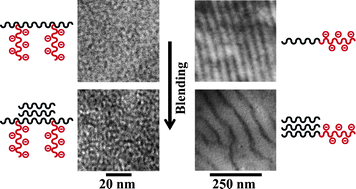
J. Mater. Chem., 2012,22, 24348-24355
https://doi.org/10.1039/C2JM31287E